wheel HONDA ACCORD HYBRID 2015 9.G Owners Manual
[x] Cancel search | Manufacturer: HONDA, Model Year: 2015, Model line: ACCORD HYBRID, Model: HONDA ACCORD HYBRID 2015 9.GPages: 569
Page 4 of 569
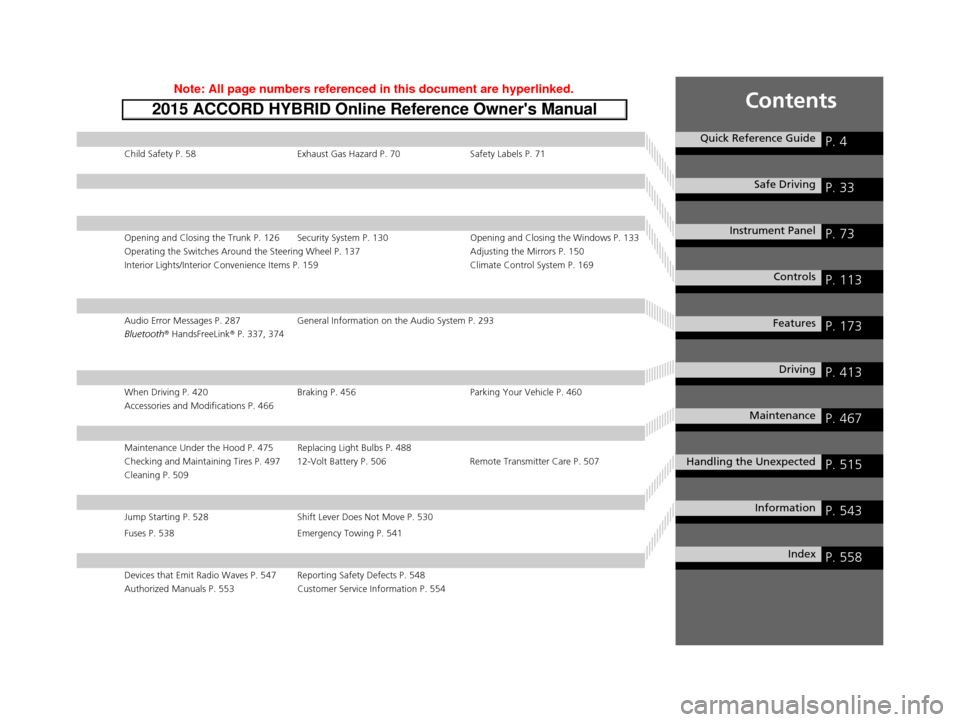
Contents
Child Safety P. 58Exhaust Gas Hazard P. 70Safety Labels P. 71
Opening and Closing the Trunk P. 126 Security System P. 130 Opening and Closing the Windows P. 133
Operating the Switches Around the Steering Wheel P. 137 Adjusting the Mirrors P. 150
Interior Lights/Interior Convenience Items P. 159 Climate Control System P. 169
Audio Error Messages P. 287General Information on the Audio System P. 293
Bluetooth® HandsFreeLink ® P. 337, 374
When Driving P. 420 Braking P. 456Parking Your Vehicle P. 460
Accessories and Modifications P. 466
Maintenance Under the Hood P. 475 Replacing Light Bulbs P. 488
Checking and Maintaining Tires P. 497 12-Volt Battery P. 506 Remote Transmitter Care P. 507
Cleaning P. 509
Jump Starting P. 528 Shift Lever Does Not Move P. 530
Fuses P. 538 Emergency Towing P. 541
Devices that Emit Radio Waves P. 547 Reporting Safety Defects P. 548
Authorized Manuals P. 553 Customer Service Information P. 554
Quick Reference GuideP. 4
Safe DrivingP. 33
Instrument PanelP. 73
ControlsP. 113
FeaturesP. 173
DrivingP. 413
MaintenanceP. 467
Handling the UnexpectedP. 515
InformationP. 543
IndexP. 558
15 ACCORD FHEV-31T3W6100.book 3 ページ 2014年7月23日 水曜日 午後3時10分
Page 6 of 569
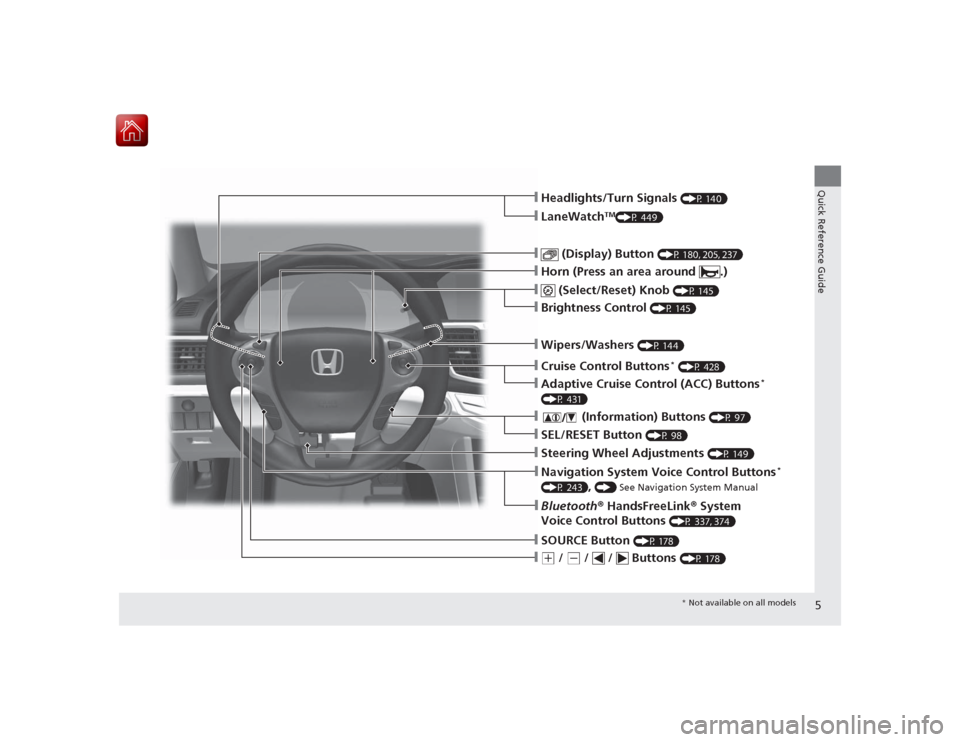
5Quick Reference Guide
❙(+
/
(-
/ / Buttons
(P 178)
❙SOURCE Button
(P 178)
❙Bluetooth® HandsFreeLink ® System
Voice Control Buttons
(P 337, 374)
❙Navigation System Voice Control Buttons
*
(P 243)
, () See Navigation System Manual
❙Steering Wheel Adjustments
(P 149)
❙SEL/RESET Button
(P 98)
❙
(Information) Buttons
(P 97)
❙Adaptive Cruise Control (ACC) Buttons
*
(P 431)❙Cruise Control Buttons
* (P 428)
❙Wipers/Washers
(P 144)
❙Brightness Control
(P 145)
❙
(Select/Reset) Knob
(P 145)
❙Horn (Press an area around .)❙
(Display) Button
(P 180, 205, 237)
❙LaneWatch
TM(P 449)
❙Headlights/Turn Signals
(P 140)* Not available on all models
Page 12 of 569
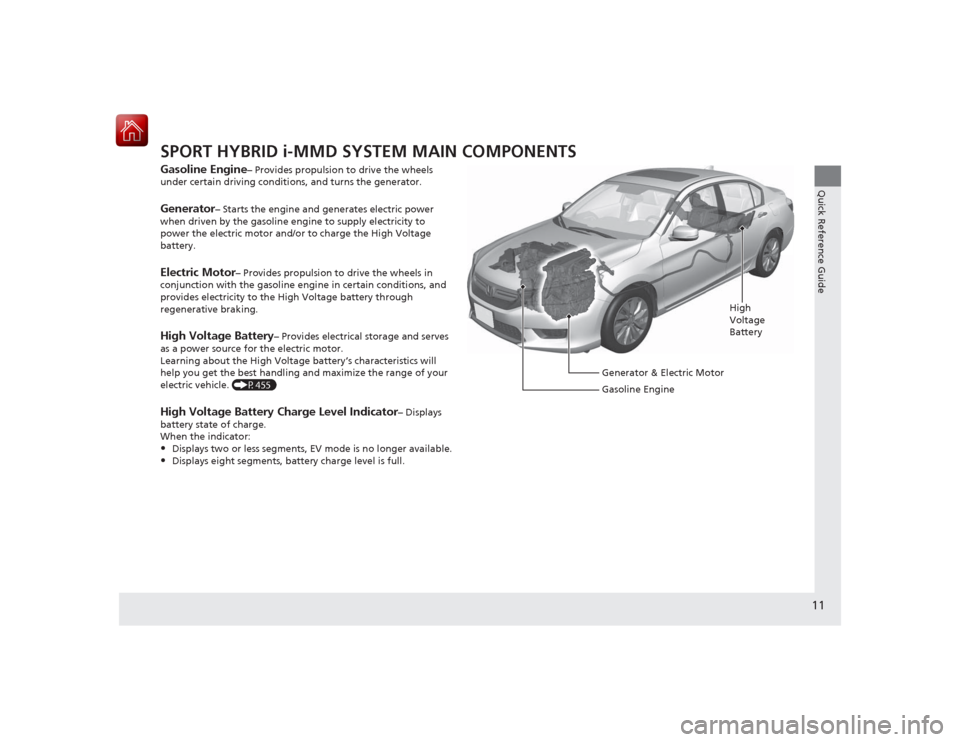
11Quick Reference Guide
SPORT HYBRID i-MMD SYSTEM MAIN COMPONENTSGasoline Engine
– Provides propulsion to drive the wheels
under certain driving conditions, and turns the generator.
Generator
– Starts the engine and generates electric power
when driven by the gasoline engine to supply electricity to
power the electric motor and/o r to charge the High Voltage
battery.
Electric Motor
– Provides propulsion to drive the wheels in
conjunction with the gasoline engine in certain conditions, and
provides electricity to the High Vol tage battery through
regenerative braking.
High Voltage Battery
– Provides electrical storage and serves
as a power source for the electric motor.
Learning about the High Voltage battery’s characteristics will
help you get the best handling and maximize the range of your
electric vehicle. (P455)
High Voltage Battery Charge Level Indicator
– Displays
battery state of charge.
When the indicator:
•Displays two or less segments, EV mo de is no longer available.•Displays eight segments, battery charge level is full.
High
Voltage
Battery
Generator & Electric Motor
Gasoline Engine
Page 13 of 569
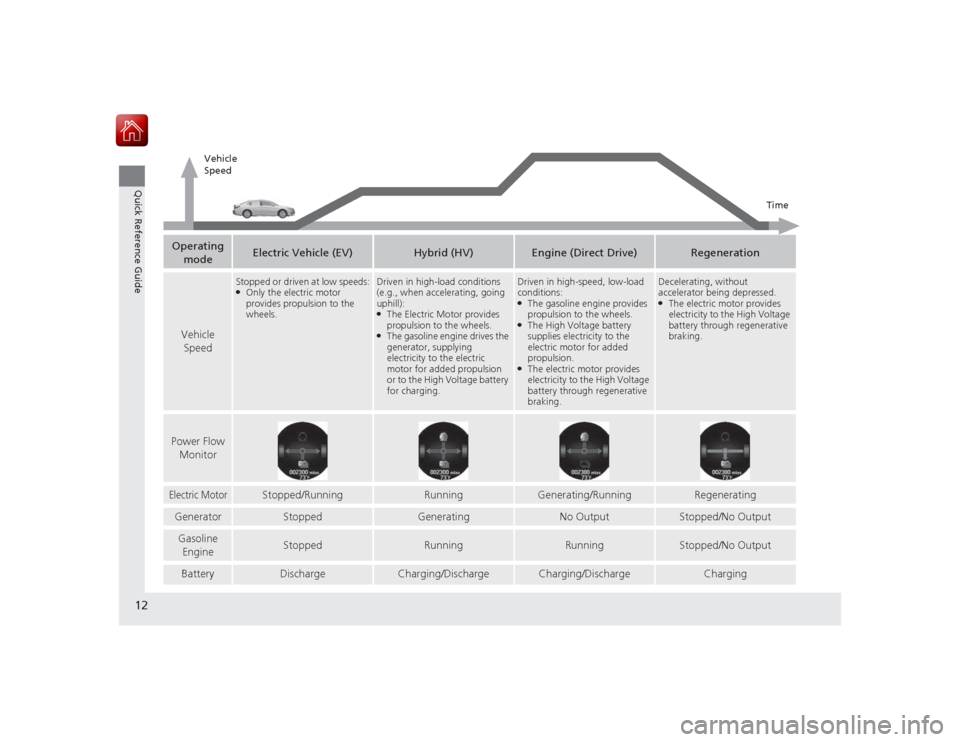
12Quick Reference Guide
Operating mode
Electric Vehicle (EV)
Hybrid (HV)
Engine (Direct Drive)
Regeneration
Vehicle Speed
Stopped or driven at low speeds:●Only the electric motor
provides propulsion to the
wheels.
Driven in high-load conditions
(e.g., when accelerating, going
uphill):●The Electric Motor provides
propulsion to the wheels.●The gasoline engine drives the
generator, supplying
electricity to the electric
motor for added propulsion
or to the High Vol tage battery
for charging.
Driven in high-speed, low-load
conditions:●The gasoline engine provides
propulsion to the wheels.●The High Voltage battery
supplies electricity to the
electric motor for added
propulsion.●The electric motor provides
electricity to the High Voltage
battery through regenerative
braking.
Decelerating, without
accelerator being depressed.●The electric motor provides
electricity to the High Voltage
battery through regenerative
braking.
Power Flow
MonitorElectric Motor
Stopped/Running
Running
Generating/Running
Regenerating
Generator
Stopped
Generating
No Output
Stopped/No Output
Gasoline Engine
Stopped
Running
Running
Stopped/No Output
Battery
Discharge
Charging/Discharge
Charging/Discharge
Charging
Vehicle
Speed
Time
Page 19 of 569
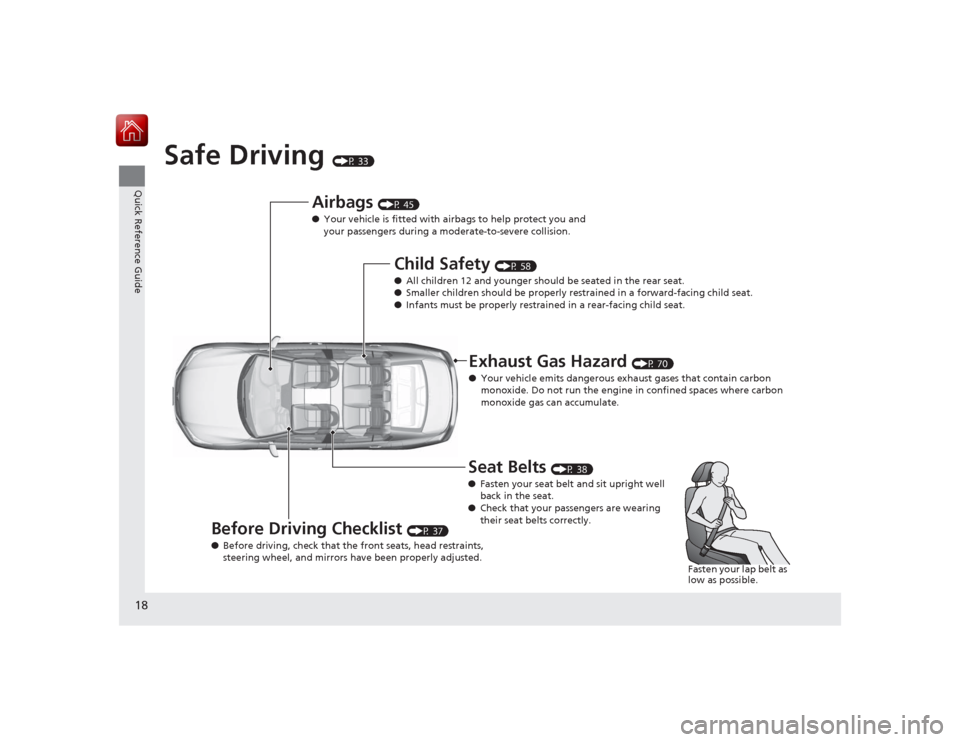
18Quick Reference Guide
Safe Driving
(P 33)
Airbags
(P 45)
● Your vehicle is fitted with airbags to help protect you and
your passengers during a moderate-to-severe collision.
Child Safety
(P 58)
● All children 12 and younger should be seated in the rear seat.
● Smaller children should be properly restrained in a forward-facing child seat.
● Infants must be properly restrained in a rear-facing child seat.
Exhaust Gas Hazard
(P 70)
● Your vehicle emits dangerous exhaust gases that contain carbon
monoxide. Do not run the eng ine in confined spaces where carbon
monoxide gas can accumulate.
Before Driving Checklist
(P 37)
● Before driving, check that the front seats, head restraints,
steering wheel, and mirrors have been properly adjusted.
Seat Belts
(P 38)
● Fasten your seat belt and sit upright well
back in the seat.
● Check that your passengers are wearing
their seat belts correctly.
Fasten your lap belt as
low as possible.
Page 22 of 569
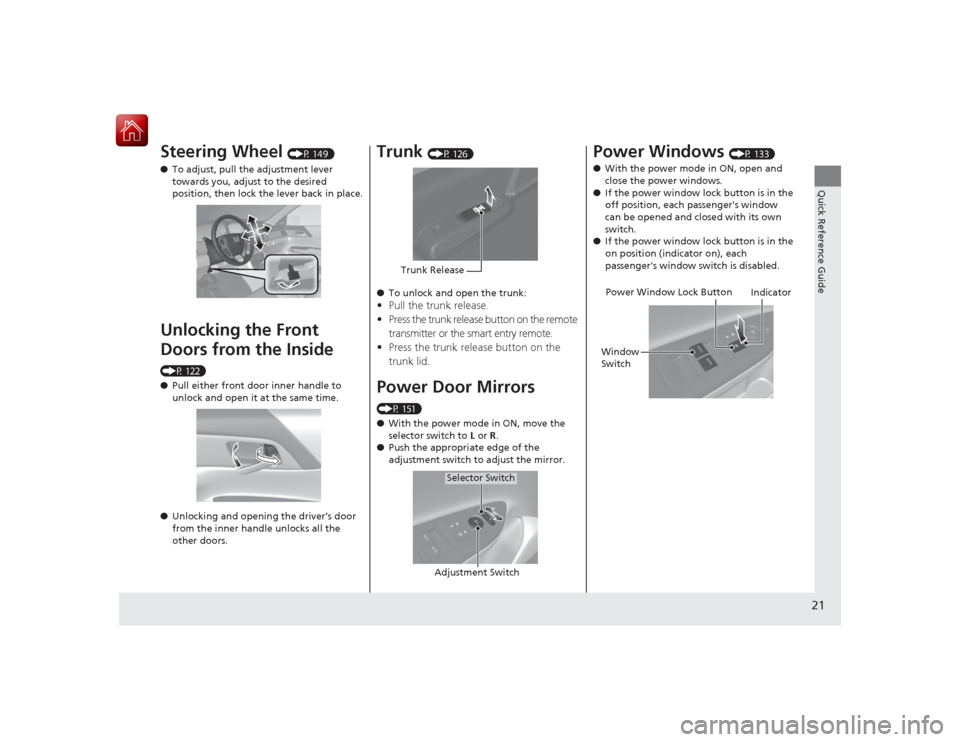
21Quick Reference Guide
Steering Wheel
(P 149)
● To adjust, pull th e adjustment lever
towards you, adjust to the desired
position, then lock the lever back in place.
Unlocking the Front
Doors from the Inside (P 122)
● Pull either front door inner handle to
unlock and open it at the same time.
● Unlocking and opening the driver’s door
from the inner handle unlocks all the
other doors.
Trunk
(P 126)
● To unlock and open the trunk:
•Pull the trunk release.
• Press the trunk release button on the remote
transmitter or the smart entry remote.
• Press the trunk release button on the
trunk lid.Power Door Mirrors(P 151)
● With the power mode in ON, move the
selector switch to L or R.
● Push the appropriate edge of the
adjustment switch to adjust the mirror.
Trunk Release
Selector Switch
Adjustment Switch
Power Windows
(P 133)
● With the power mode in ON, open and
close the power windows.
● If the power window lock button is in the
off position, each passenger's window
can be opened and closed with its own
switch.
● If the power window lock button is in the
on position (indicator on), each
passenger's window switch is disabled.
Power Window Lock Button
Window
Switch Indicator
Page 27 of 569
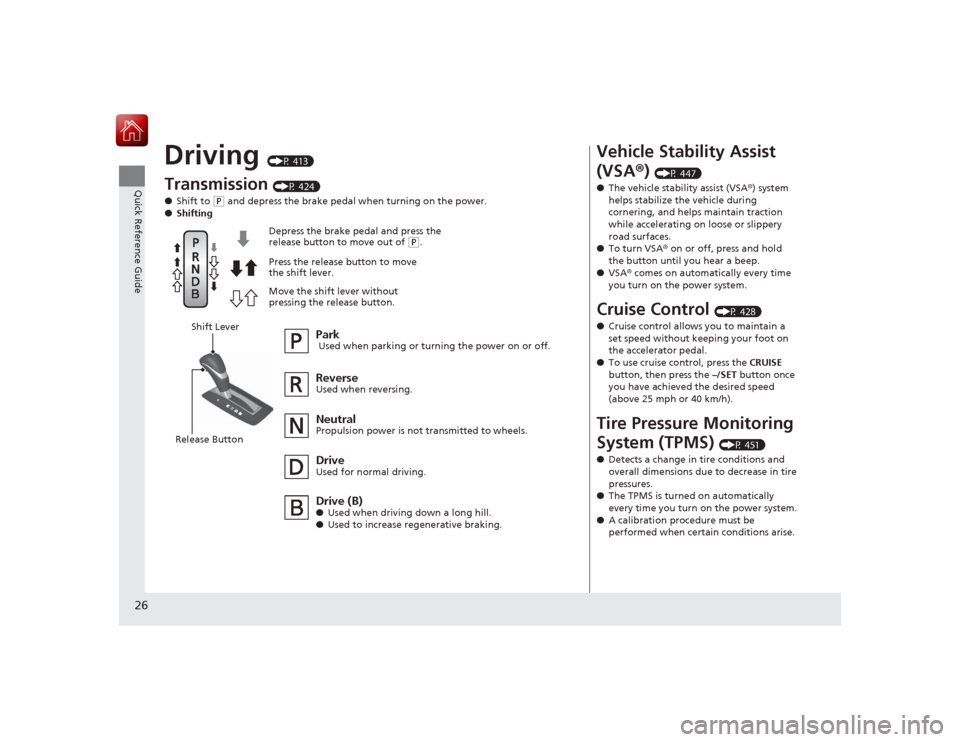
26Quick Reference Guide
Driving
(P 413)
Transmission
(P 424)
● Shift to
(P and depress the brake pedal wh en turning on the power.
● Shifting
Park Used when parking or turning the power on or off.NeutralPropulsion power is not transmitted to wheels.Drive (B)●Used when driving down a long hill.
● Used to increase regenerative braking.
Depress the brake pedal and press the
release button to move out of
(
P.
Press the release button to move
the shift lever.
Move the shift lever without
pressing the release button.
ReverseUsed when reversing.DriveUsed for normal driving.
Shift Lever
Release Button
Vehicle Stability Assist
(VSA ®)
(P 447)
● The vehicle stability assist (VSA ®) system
helps stabilize the vehicle during
cornering, and helps maintain traction
while accelerating on loose or slippery
road surfaces.
● To turn VSA ® on or off, press and hold
the button until you hear a beep.
● VSA ® comes on automatically every time
you turn on the power system.
Cruise Control
(P 428)
● Cruise control allows you to maintain a
set speed without keeping your foot on
the accelerator pedal.
● To use cruise control, press the CRUISE
button, then press the –/SET button once
you have achieved the desired speed
(above 25 mph or 40 km/h).
Tire Pressure Monitoring
System (TPMS)
(P 451)
● Detects a change in tire conditions and
overall dimensions due to decrease in tire
pressures.
● The TPMS is turned on automatically
every time you turn on the power system.
● A calibration procedure must be
performed when certain conditions arise.
Page 29 of 569
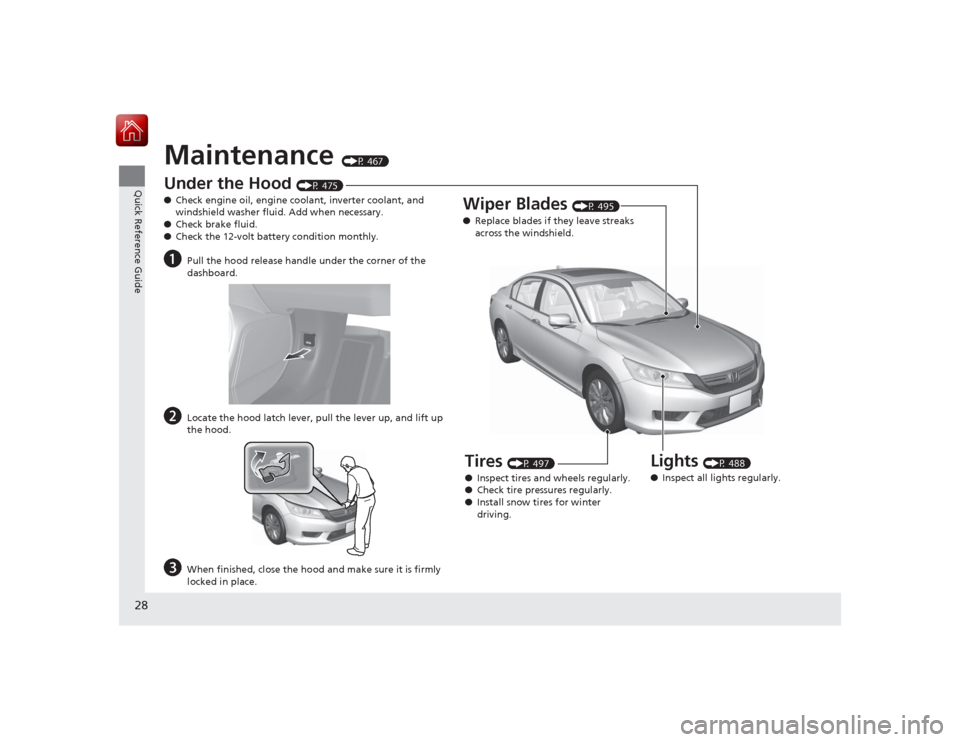
28Quick Reference Guide
Maintenance
(P 467)
Under the Hood
(P 475)
● Check engine oil, engine coolant, inverter coolant, and
windshield washer fluid. Add when necessary.
● Check brake fluid.
● Check the 12-volt battery condition monthly.
a
Pull the hood release handle under the corner of the
dashboard.
b
Locate the hood latch lever, pull the lever up, and lift up
the hood.
c
When finished, close the hood and make sure it is firmly
locked in place.
Lights
(P 488)
● Inspect all lights regularly.
Wiper Blades
(P 495)
● Replace blades if they leave streaks
across the windshield.
Tires
(P 497)
● Inspect tires and wheels regularly.
● Check tire pressures regularly.
● Install snow tires for winter
driving.
Page 31 of 569
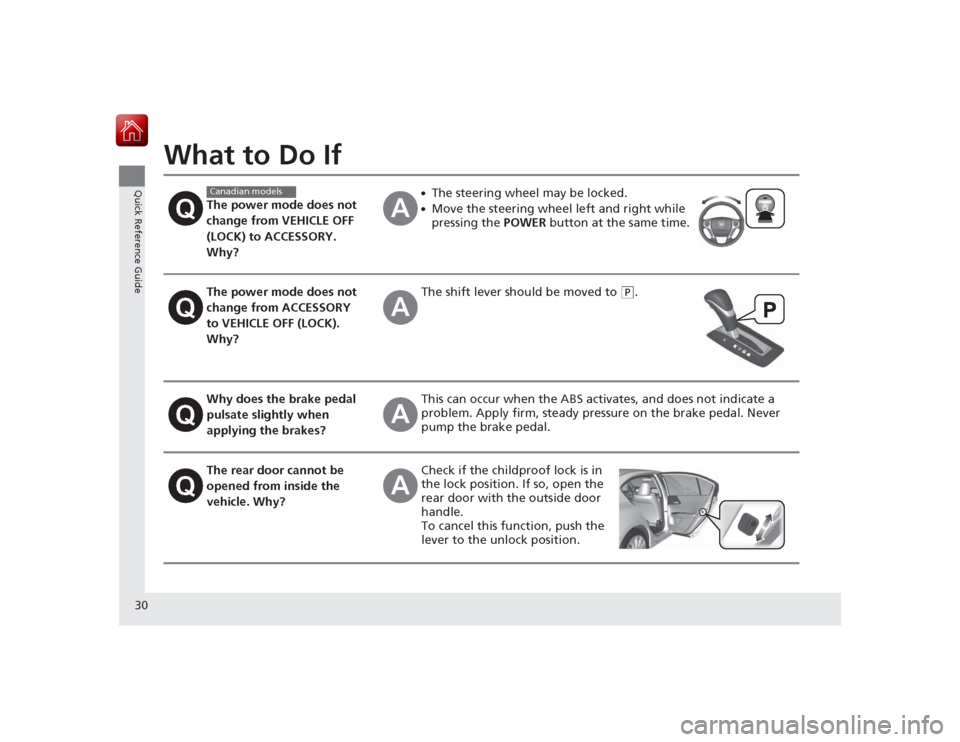
30Quick Reference Guide
What to Do If
The power mode does not
change from VEHICLE OFF
(LOCK) to ACCESSORY.
Why?
●The steering wheel may be locked.●Move the steering wheel left and right while
pressing the POWER button at the same time.
The power mode does not
change from ACCESSORY
to VEHICLE OFF (LOCK).
Why?
The shift lever s hould be moved to
(P
.
Why does the brake pedal
pulsate slightly when
applying the brakes?
This can occur when the ABS act ivates, and does not indicate a
problem. Apply firm, steady pressure on the brake pedal. Never
pump the brake pedal.
The rear door cannot be
opened from inside the
vehicle. Why?
Check if the childproof lock is in
the lock position . If so, open the
rear door with the outside door
handle.
To cancel this function, push the
lever to the unlock position.
Canadian models
Page 47 of 569
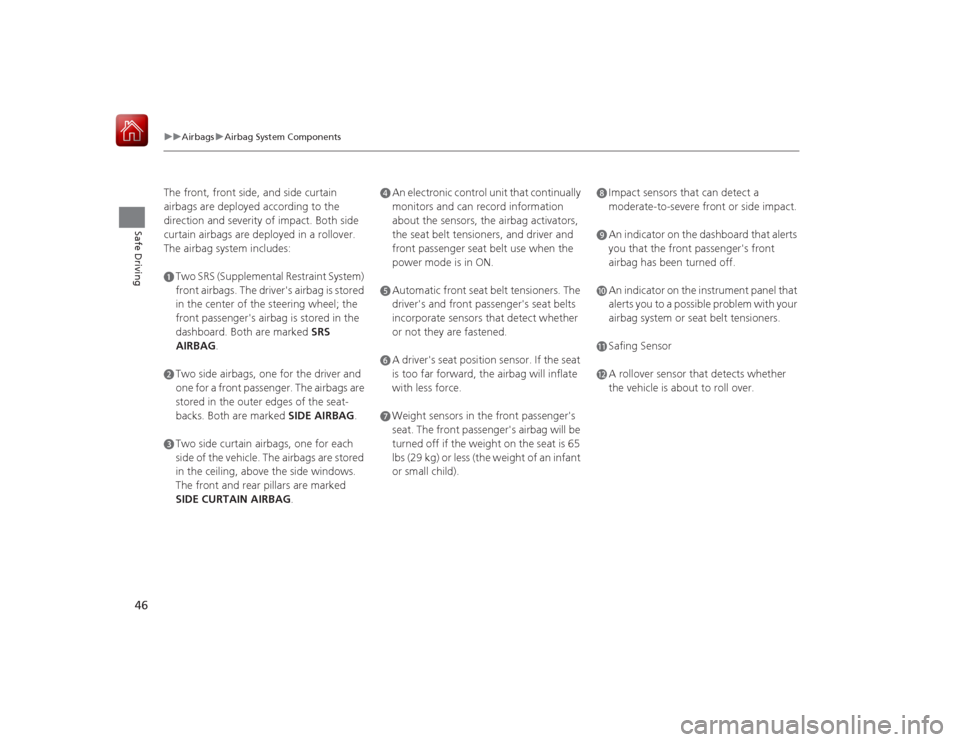
46
uuAirbags uAirbag System Components
Safe Driving
The front, front side, and side curtain
airbags are deployed according to the
direction and severity of impact. Both side
curtain airbags are deployed in a rollover.
The airbag system includes:aTwo SRS (Supplemental Restraint System)
front airbags. The driver's airbag is stored
in the center of the steering wheel; the
front passenger's airbag is stored in the
dashboard. Both are marked SRS
AIRBAG.bTwo side airbags, one for the driver and
one for a front passenger. The airbags are
stored in the outer edges of the seat-
backs. Both are marked SIDE AIRBAG .cTwo side curtain airbags, one for each
side of the vehicle. The airbags are stored
in the ceiling, above the side windows.
The front and rear pillars are marked
SIDE CURTAIN AIRBAG.
dAn electronic control unit that continually
monitors and can record information
about the sensors, the airbag activators,
the seat belt tensioners, and driver and
front passenger seat belt use when the
power mode is in ON.eAutomatic front seat belt tensioners. The
driver's and front passenger's seat belts
incorporate sensors that detect whether
or not they are fastened.fA driver's seat position sensor. If the seat
is too far forward, the airbag will inflate
with less force.gWeight sensors in the front passenger's
seat. The front passenger's airbag will be
turned off if the weight on the seat is 65
lbs (29 kg) or less (the weight of an infant
or small child).
hImpact sensors that can detect a
moderate-to-severe front or side impact.iAn indicator on the dashboard that alerts
you that the front passenger's front
airbag has been turned off.jAn indicator on the instrument panel that
alerts you to a possible problem with your
airbag system or seat belt tensioners.kSafing SensorlA rollover sensor that detects whether
the vehicle is about to roll over.